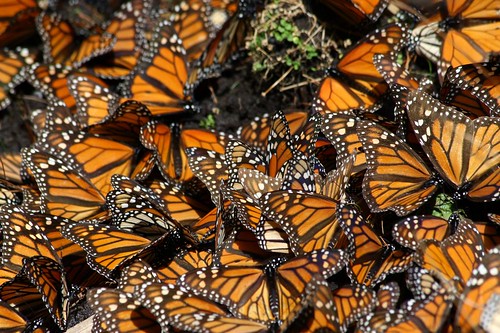美國農業部最近的研究發現,屬於新菸鹼類(neonicotinoids)殺蟲劑的可尼丁(clothianidin),是造成北美帝王蝶(monarch butterfly)減少的可能原因。針對新菸鹼類殺蟲劑對帝王蝶或任何其他蝶類造成的影響,這是第一篇研究報告。
10億分之一的可尼丁 就可能害了毛毛蟲
2015年4月3日發佈的這項研究鑑定,只要濃度10億分之一的可尼丁,就會對帝王蝶的幼蟲有害。
研究人員Jacob Pecenka與Jonathan Lundgren在南達科他州(South Dakota)布魯金斯(Brookings)所取樣的乳草種群中發現此可尼丁的濃度,並將這項研究發表在期刊《科學與自然》(Science and Nature)上。
其他的研究已經顯示,新菸鹼類殺蟲劑可能阻礙授粉,促使歐盟禁用這類殺蟲劑在對蜜蜂有吸引力的農作物上,並且加速美國環保署的審查。
15年來持續下滑 帝王蝶今年估計再少30%
帝王蝶每年從墨西哥中部山區遷徙2500英里到加拿大並回返,是北美象徵性的物種,數量持續下降已經15年了。
帝王蝶的數量曾經多達10億隻,而2015年1月在墨西哥的避難處,僅僅剩下5650萬隻,是有史以來總量第二低。
同時,一名德州農工大學的研究人員表示,世界自然基金會(WWF)、私人捐助者和墨西哥米卻肯州(Michoacan)的報告顯示,帝王蝶因每年從墨西哥的孕育地跋涉到德州,在2012年數量減少將近30%。
研究員Wilson警告:「最新資訊顯示,今年帝王蝶將減少25至30%,而且這已經是近幾年令人擔憂的趨勢。」
改種農作物 蝴蝶食草、棲地都喪失
「去年在帝王蝶南遷時,這個區域嚴重的乾旱與火災無疑地造成花蜜減少。」研究員Wilson表示,「然而,因農民在休耕地種植以抗除草劑玉米和大豆為主的農作物,或過度使用除草劑和割草,而乳草是重要的植物,因為雌蝶只會在乳草上產卵。估計帝王蝶每年喪失數百萬英畝的棲地。」
堪薩斯大學(University of Kansas)的「帝王蝶觀察」(Monarch Watch)計畫主任Chip Taylor估計,先前帝王蝶的棲地,已經喪失了1億英畝。
賓州州立大學(Pennsylvania State University)農學院(College of Agricultural Sciences)的研究人員表示,幾乎可說是因為使用經農藥處理的玉米與大豆種子,而造成2000年代中期新菸鹼類殺蟲劑使用增加。
「我們的研究成果顯示,自從2000年代中期,用新菸鹼類殺蟲劑處理玉米或大豆的種子,在美國已經是造成受殺蟲劑注入的玉米耕地激增的主因。」
大量耕地經殺蟲劑處理 實際效果不明
研究人員從美國地質調查局和美國農業部彙整農藥資料,發現這兩個公開來源都列出新菸鹼類殺蟲劑的使用情況,卻沒有對種子的使用處理做調查。
研究團隊以美國環保署和種子首要供應公司杜邦先鋒(DuPont Pioneer)的資訊,證實了他們的研究成果。
研究團隊發現,2000年有低於5%的大豆耕地與低於30%的玉米耕地經殺蟲劑處理,但是在2011年,至少有1/3的大豆耕地與至少79%的玉米耕地,是栽種覆蓋有新尼古丁類殺蟲劑的種子。
2015年3月31日,他們的研究成果發表在線上期刊《環境科學與技術》(Environmental Science and Technology)。
「種子公司與農民迅速地採用新尼古丁類殺蟲劑,但看起來與對應的害蟲風險不太相關。」賓州州立大學昆蟲學系副教授John Tooker表示,「模式顯示,新尼古丁類殺蟲劑常常做為對抗不明蟲害的『保單』,而非用來對付記載中的害蟲威脅。」
美環團指控官方拖延
2015年2月,非營利團體自然資源保護委員會(NRDC)指控美國環保署一再拖延帝王蝶的拯救工作,並提起訴訟強制環保局採取行動。
一年多前,自然資源保護委員會提出另一種化學除草劑嘉磷塞(glyphosate)已持續破壞帝王蝶的棲地。美國紐約市區法庭提出了訴訟,聲明美國環保署未能對限制嘉磷塞的緊急請願書做出反應,已經導致無辜的帝王蝶群「顯著的持續傷害」(significant on going harm)。
自然資源保護委員會的科學家兼野生動物保育計畫主任Sylvia Fallon博士表示:「環保署拖延越久,帝王蝶遷徙種消失的風險就越大。」
The neonicotinoid insecticide clothianidin is a likely contributor to monarch butterfly declines in North America, finds new research by a team from the U.S. Department of Agriculture. Theirs is the first report of neonicotinoids affecting monarchs or any other butterflies.
The research, published on Friday, identifies concentrations of clothianidin as low as one part per billion as harmful to monarch butterfly caterpillars. These concentrations of clothianidin were found in the populations of milkweeds sampled by the researchers.
The research by Jacob Pecenka and Jonathan Lundgren was conducted in Brookings, South Dakota and is published in the journal “Science and Nature.”
Meanwhile, a Texas A&M University researcher says reports by the World Wildlife Fund, private donors and Mexico’s Michoacan state show that Monarch numbers were down almost 30 percent in 2012 as they make their annual trek from their breeding grounds in Mexico and move across Texas.
Craig Wilson, a senior research associate in the Center for Mathematics and Science Education and a long-time butterfly enthusiast, says the figures show an alarming decades-long decline in their numbers.
“The latest information shows that Monarchs will be down from 25 to 30 percent this year, and that has been part of a disturbing trend the last few years,” Wilson warns.
“Last year’s severe drought and fires in the region no doubt played a part, resulting in less nectar for the Monarchs as they migrated south,” Wilson said. “But estimates show that each year, millions of acres of land are being lost that would support Monarchs, either by farmers converting dormant land for crop use – mainly to herbicide tolerant corn and soybeans – or the overuse of herbicides and mowing. Milkweed is the key plant because it’s the only plant where the female will lay her eggs.”
Chip Taylor, director of Monarch Watch at the University of Kansas, estimates that 100 million acres of land have already been lost that previously supported Monarchs.
Use of neonicotinoids increased in the mid-2000s, driven almost entirely by the use of corn and soybean seeds treated with the pesticides, according to researchers in Penn State’s College of Agricultural Sciences.
“Previous studies suggested that the percentage of corn acres treated with insecticides decreased during the 2000s, but once we took seed treatments into account we found the opposite pattern,” said Margaret Douglas, graduate student in the Penn State Department of Entomology.
“Our results show that application of neonicotinoids to seed of corn and soybeans has driven a major surge in U.S. cropland treated with insecticides since the mid-2000s,” Douglas said.
Other research has suggested that neonicotinoids may harm pollinators, prompting their suspension on bee-attractive crops in the European Union and expediting their review by the U.S. Environmental Protection Agency.
After discovering that neonicotinoid seed treatments were not documented explicitly in U.S. government pesticide surveys, the researchers synthesized available information to characterize the use of these widespread insecticides.
First they compiled pesticide data from two public sources, the U.S. Geological Survey and the U.S. Department of Agriculture, that both reported aspects of neonicotinoid use, but did not estimate seed treatment use.
Using these data, together with information from insecticide product labels, the team estimated the percentage of land in corn and soybeans in which neonicotinoid-treated seeds were used since these products were introduced in the mid-2000s.
They corroborated their results with information from the U.S. Environmental Protection Agency and DuPont Pioneer, a major seed supplier.
The team found that in 2000, less than five percent of soybean acres and less than 30 percent of corn acres were treated with an insecticide, but by 2011, at least a third of all soybean acres and at least 79 percent of all corn acres were planted with neonicotinoid-coated seed, constituting a significant expansion in insecticide use.
The researchers also found that the vast majority of neonicotinoids are used on crops, rather than in people’s homes or gardens, or in turfgrass and ornamental settings.
Their results were published online Thursday in the journal “Environmental Science and Technology.”
“Adoption of neonicotinoid insecticides by seed companies and farmers has been very rapid and does not appear to relate well to a corresponding risk from insect pests,” said John Tooker, Penn State associate professor of entomology. “This pattern suggests that neonicotinoids often are being used as an ‘insurance policy’ against uncertain insect attack, rather than in response to a documented pest threat.”
In February, the nonprofit Natural Resources Defense Council accused the Environmental Protection Agency of dragging its feet on efforts to save the imperiled monarch butterfly and filed a lawsuit to force the agency to act.
EPA’s failure to respond to an urgent petition that sought to limit the use of another chemical, the herbicide glyphosate, that has been destroying monarch habitat, filed more than a year ago by NRDC, has resulted in “significant ongoing harm” to the vulnerable butterfly population, claims the suit, filed in the U.S. District Court in New York City.
“The longer EPA delays, the greater the risk we could lose the monarch migration,” said Dr. Sylvia Fallon, an NRDC scientist and director of its Wildlife Conservation Project.
The monarch butterfly, an iconic North American species that makes a unique 2,500 mile annual migration from the mountains of central Mexico to Canada and back, has been in decline for 15 years.
Once numbering as many as a billion butterflies, only 56.5 million Monarchs were counted in January at their Mexican refuge, the second lowest total ever.
※ 全文及圖片詳見:ENS







